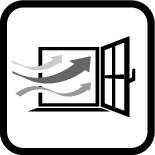Safety instructions

Read all the safety information and instructions. Failure to observe the safety information and follow instructions may result in electric shock, fire and/or serious injury.
Save all warnings and instructions for future reference.
- This heat gun is not intended for use by children or persons with physical, sensory or mental limitations or a lack of experience or knowledge. This heat gun can be used by children aged 8 or older and by persons who have physical, sensory or mental limitations or a lack of experience or knowledge if a person responsible for their safety supervises them or has instructed them in the safe operation of the heat gun and they understand the associated dangers. Otherwise there is a risk of operating errors and injury.
- Supervise children during use, cleaning and maintenance. This will ensure that children do not play with the heat gun.
- Handle the heat gun with care. The heat gun produces intense heat which increases the risk of fire and explosion.
- Take particular care when working in the vicinity of flammable materials. The hot airflow or hot nozzle may ignite dust or gases.
- Do not work with the heat gun in potentially explosive areas.
- Do not aim the hot airflow at the same area for prolonged periods. Working with plastic, paint, varnish or similar materials may produce easily flammable gases.
- Please be aware that heat is directed to covered flammable materials, which may ignite.
- Safely place the heat gun on the storage surfaces after use and let it cool completely before packing it away. The hot nozzle can cause damage.
- Do not let children use the heat gun unsupervised when it is switched on.
- Store idle heat guns out of the reach of children. Do not allow persons unfamiliar with the heat gun or these instructions to operate the tool. Heat guns can be dangerous in the hands of untrained users.
- Do not expose the heat gun to rain or wet conditions. Water entering a heat gun increases the risk of electric shock.
- Do not misuse the cable, for example by using it to carry, hang up or unplug the heat gun. Keep the cable away from heat and oil. Damaged or entangled cords increase the risk of electric shock.
- Always wear safety goggles. Safety goggles reduce the risk of injury.
- Pull the plug out of the socket before adjusting the tool settings, changing accessories, or storing the heat gun. This safety measure prevents the heat gun from being started accidentally.
- Always check the heat gun, cable and plug before use. Stop using the heat gun if you discover any damage. Do not open the heat gun yourself, and have it repaired only by a qualified specialist using only original replacement parts. Damaged heat guns, cables and plugs increase the risk of electric shock.

Keep your work area well-ventilated. The gas and steam produced during work are often harmful to one's health.
- Wear protective gloves and do not touch the nozzle while it is hot. There is a risk of burns.
- Do not direct the airflow at persons or animals.
- Do not use the heat gun as a hair dryer. The outgoing airflow is considerably hotter than that of a hair dryer.
- Do not allow foreign objects to enter the heat gun.
- The distance between the nozzle and the workpiece depends on the material you are working on (metal, plastic, etc.) and the intended working method. Always test the amount of air and temperature first.
- If operating the heat gun in a damp environment is unavoidable, use a residual current device (RCD). Use of an RCD reduces the risk of electric shock.
- Never use the heat gun if the cable is damaged. Do not touch the damaged cable and pull out the mains plug if the cable is damaged while working. Damaged cables increase the risk of an electric shock.
Products sold in GB only:
Your product is fitted with an BS 1363/A approved electric plug with internal fuse (ASTA approved to BS 1362).
If the plug is not suitable for your socket outlets, it should be cut off and an appropriate plug fitted in its place by an authorised customer service agent. The replacement plug should have the same fuse rating as the original plug.
The severed plug must be disposed of to avoid a possible shock hazard and should never be inserted into a mains socket elsewhere.